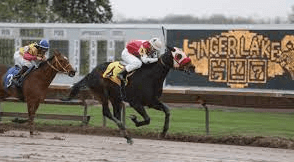How Can One Bet On Thoroughbred Horse Racing?

Thoroughbred horse racing is a popular and exhilarating sport that has captivated audiences for centuries. For those who are new to the world of horse racing, understanding how to bet on these races can seem like an overwhelming task. However, with some knowledge and guidance, anyone can navigate the intricacies of thoroughbred horse racing betting.
To start, it is crucial to comprehend the different types of bets available in this sport. From simple win bets where you choose the winning horse, to more complex exotic bets such as exactas or trifectas where you predict the order of multiple horses, there are various options to suit different gambling preferences. By understanding these bet types and their corresponding odds, bettors can make informed decisions on which wagers to place.
Once familiar with the betting options, it becomes essential to research both the horses and their respective odds before making any wagers. This involves studying factors such as past performance records, jockey statistics, track conditions, and trainer success rates. Thoroughly analyzing this information will enable bettors to identify potential contenders and weigh their chances accurately. Additionally, comparing odds from different bookmakers allows individuals to seek out the best value for their wagers.
By mastering these fundamental aspects of thoroughbred horse racing betting – comprehending various bet types and conducting thorough research – individuals can enhance their chances of making successful wagers. Furthermore, managing one’s bankroll wisely is crucial in maintaining longevity in this pursuit. Implementing strategies such as setting a budget for each race day or using a percentage-based staking plan ensures responsible gambling habits while maximizing potential profits.
Overall, navigating the world of thoroughbred horse racing betting requires knowledge, analysis skills, and disciplined bankroll management; yet it offers an exciting avenue for those seeking both intellectual stimulation and a chance at financial freedom through strategic wagering.
Understanding the Different Types of Bets
Various types of bets are available in thoroughbred horse racing, each offering a unique opportunity for bettors to engage with the sport and potentially earn a profit.
One popular betting strategy involves analyzing racing forms, which provide valuable information about the horses’ past performances, trainers, jockeys, and track conditions. By studying these forms meticulously, bettors can make more informed decisions when placing their bets.
Some common types of bets include win, place, and show bets. A win bet requires selecting the horse that will finish first in the race, while a place bet is won if the selected horse finishes either first or second. A show bet pays out if the chosen horse finishes in one of the top three positions.
Other types of bets include exacta (predicting which two horses will finish first and second), trifecta (predicting which three horses will finish first, second, and third), and superfecta (predicting which four horses will finish first through fourth). These exotic bets often offer higher payouts but require more skill and luck to win.
Overall, understanding different types of bets and utilizing effective betting strategies like analyzing racing forms can greatly enhance one’s experience in thoroughbred horse racing betting while increasing their chances of making profitable wagers.
Finding the Best Odds and Researching the Horses
Different sources of information can be explored to uncover the most favorable odds and conduct thorough research on the equine contenders.
To gain insight into the potential performance of a horse, analyzing track conditions is crucial. By studying past race results and considering factors such as weather conditions, track surface, and distance, one can better understand how a particular horse may fare in upcoming races.
Additionally, researching jockey statistics can provide valuable insights into their past performance and success rates. Examining a jockey’s win percentage, average earnings per start, and experience levels can help bettors make more informed decisions when placing bets on thoroughbred horse racing.
Moreover, keeping up with news articles and expert analysis from reputable sources can offer valuable insights into any recent developments or changes that could impact a horse’s performance.
By utilizing these strategies for finding the best odds and researching horses thoroughly, individuals can enhance their chances of making successful bets on thoroughbred horse racing events.
Placing Your Bets and Managing Your Bankroll
This discussion will focus on three key points related to placing bets and managing one’s bankroll in thoroughbred horse racing.
The first point involves setting a budget and adhering to it, which is crucial for responsible gambling and preventing excessive losses.
Secondly, utilizing different betting strategies can enhance the chances of making profitable wagers by considering various factors such as past performance, jockey-trainer combinations, and track conditions.
Lastly, understanding odds and payouts is essential in order to assess the potential return on investment for different types of bets and make informed decisions when placing wagers.
Setting a Budget and Sticking to It
To effectively manage their spending, individuals interested in betting on thoroughbred horse racing should establish a well-defined budget and adhere to it consistently.
Creating a betting schedule can be helpful in managing finances and avoiding impulsive decisions. By setting specific limits for each race or event, bettors can ensure that they are not spending more than they can afford.
It is important to allocate a certain amount of money solely for betting purposes and not exceed this predetermined limit. Additionally, avoiding emotional betting is crucial in sticking to the budget.
Emotions such as excitement or disappointment can cloud judgment and lead to irrational bets. It is essential to make decisions based on careful analysis of the horses’ form, jockeys, trainers, track conditions, and other relevant factors rather than being swayed by emotions.
By following these guidelines and maintaining discipline in financial management, individuals can enjoy the thrill of horse racing while staying within their means.
Using Different Betting Strategies
Various approaches to wagering can be employed in the pursuit of success in the realm of thoroughbred racing, each with its own unique twist on strategy and potential for reward.
One popular betting strategy is betting on longshots, which are horses that have high odds of winning but are considered unlikely contenders. This approach appeals to those who enjoy taking risks and seeking big payouts.
Another effective method is using handicapping techniques, which involve analyzing various factors such as past performance, jockey skills, track conditions, and horse form to determine a horse’s chances of winning. By utilizing these techniques, bettors can make more informed decisions and increase their chances of selecting a winning horse.
These strategies not only add excitement to the betting experience but also provide an opportunity for individuals to exercise their analytical skills and potentially achieve substantial financial gains in the process.
Understanding Odds and Payouts
An essential aspect of engaging in thoroughbred racing is gaining a comprehensive understanding of the odds and payouts associated with different betting strategies. To fully grasp this concept, it is crucial to familiarize oneself with the various betting terminologies used in horse racing.
Some common terms include ‘win,’ where bettors predict which horse will finish first; ‘place,’ where bettors wager on a horse finishing either first or second; and ‘show,’ where bettors bet on a horse finishing in the top three positions. Understanding these terms allows individuals to make informed decisions when placing their bets.
Additionally, calculating potential payouts requires knowledge of how odds are determined. The odds reflect the likelihood of a particular outcome, with higher odds indicating a lower chance of winning but potentially higher payouts if successful. By multiplying the amount wagered by the odds, individuals can estimate their potential winnings.
It is important to note that these calculations should also account for taxes and deductions made by race tracks or bookmakers.
Overall, comprehending betting terminology and being able to calculate potential payouts enhances one’s ability to navigate thoroughbred racing successfully.
Frequently Asked Questions
What are the different types of bets available in thoroughbred horse racing?
The different types of horse racing bets include win, place, show, exacta, trifecta, and superfecta. Potential winnings in horse racing bets can be calculated based on the odds and amount wagered on a particular bet.
How can I find the best odds and research the horses before placing my bets?
Finding reliable sources and understanding betting odds are crucial when researching horses before placing bets. By analyzing expert opinions, past performance records, and studying the odds from reputable bookmakers, bettors can make informed decisions that increase their chances of success.
What strategies can I use to manage my bankroll effectively while betting on horse racing?
Effective bankroll management strategies are crucial when betting on horse racing. Implementing a disciplined approach, such as setting a budget, using percentage-based wagering, and tracking results, can help ensure long-term profitability. Additionally, utilizing proven betting systems can further enhance one’s chances of success in this endeavor.
Are there any specific factors or statistics that I should consider while researching horses?
When analyzing horse racing data, it is important to consider factors such as speed figures, jockey and trainer performance, track conditions, and previous race results. These statistics provide valuable insights into a horse’s potential performance and can assist in making informed betting decisions.
Is there a minimum or maximum amount of money I can bet on a horse race?
Minimum bet restrictions and maximum bet restrictions are common in horse racing. These limits vary depending on the track and the type of bet being placed, ensuring fairness and preventing excessive risk-taking by bettors.
Conclusion
Thoroughbred horse racing is a complex and fascinating sport that offers numerous opportunities for betting. By understanding the different types of bets, such as win, place, and show, bettors can make informed decisions based on their research of the horses and their odds.
It is crucial to find the best odds available and thoroughly research each horse’s past performance, jockey history, and track conditions before placing any bets.
Placing your bets requires careful consideration of your bankroll management. It is essential to set a budget for your wagers and stick to it, ensuring you do not get carried away in the excitement of the race. By managing your bankroll effectively, you can minimize losses and maximize potential winnings.
In conclusion, thoroughbred horse racing provides an exhilarating experience for those who enjoy wagering on this timeless sport. The thrill of analyzing each horse’s form guide while searching for hidden gems among the odds is both challenging and rewarding.
However, it is important to approach betting with caution and discipline by understanding the various bet types available and conducting thorough research on each contender before making any wagers. By doing so, bettors can increase their chances of success while immersing themselves in the captivating world of thoroughbred horse racing.



